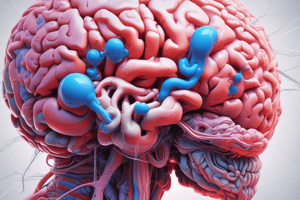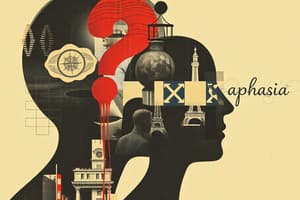Podcast
Questions and Answers
Which of the following best describes the primary characteristic of breptavost?
Which of the following best describes the primary characteristic of breptavost?
- Complete inability to speak due to psychological trauma.
- Loss of previously acquired speech abilities due to brain injury.
- Difficulties in learning to communicate verbálly despite adequate conditions.
- Extremely rapid speech rate that affects fluency. (correct)
A child exhibits selective mutism, only speaking to their parents at home, but remaining silent at school. According to the information, what is the MOST likely cause of this behavior?
A child exhibits selective mutism, only speaking to their parents at home, but remaining silent at school. According to the information, what is the MOST likely cause of this behavior?
- Anatomical abnormalities in the child's articulatory organs.
- Underlying neurological or motor disorders.
- Inappropriate educational strategies or emotional experiences the child experienced. (correct)
- Inconsistent disciplinary approaches used at home and school.
Which statement accurately differentiates between dyslalia and dysarthria?
Which statement accurately differentiates between dyslalia and dysarthria?
- Dyslalia specifically affects single sounds, while dysarthria presents as a global articulation disorder. (correct)
- Dyslalia involves total speech loss, while dysarthria affects articulation.
- Dyslalia is always caused by neuromotor conditions, unlike dysarthria.
- Dyslalia is an acquired speech disorder, whereas dysarthria is developmental.
Which factor is LEAST likely to cause chraptivost (dysphonia)?
Which factor is LEAST likely to cause chraptivost (dysphonia)?
A patient presents with rhinolalia. Further examination reveals a restricted nasal passage. What specific type of rhinolalia is the patient MOST likely experiencing?
A patient presents with rhinolalia. Further examination reveals a restricted nasal passage. What specific type of rhinolalia is the patient MOST likely experiencing?
What is the PRIMARY difference between afasie and vývojová dysfázie?
What is the PRIMARY difference between afasie and vývojová dysfázie?
A person stutters, and is characterized by hesitations or prolongations in their speech. What is the MOST appropriate term for this condition?
A person stutters, and is characterized by hesitations or prolongations in their speech. What is the MOST appropriate term for this condition?
Which of the following is an example of an exogenous cause of dyslalia?
Which of the following is an example of an exogenous cause of dyslalia?
A child who is exposed to psychological trauma cannot speak. What condition does the child likely have?
A child who is exposed to psychological trauma cannot speak. What condition does the child likely have?
What measure is MOST important for preventing voice disorders in children?
What measure is MOST important for preventing voice disorders in children?
Flashcards
Vývojová dysfázie / Developmental Dysphasia
Vývojová dysfázie / Developmental Dysphasia
Specific developmental speech disorder due to early brain damage affecting speech zones in a developing child's brain, impairing verbal communication skills despite adequate conditions.
Afázie / Aphasia
Afázie / Aphasia
Loss of already learned speech abilities (speaking, writing, reading) caused by damage to the left cerebral hemisphere, often after stroke, injury, or tumors; variable symptoms.
Breptavost / Cluttering
Breptavost / Cluttering
A speech tempo disorder characterized by an extremely rapid rate of speech, leading to omitted syllables, revisions, repetitions, and content deformation.
Koktavost / Stuttering
Koktavost / Stuttering
Signup and view all the flashcards
Mutismus / Mutism
Mutismus / Mutism
Signup and view all the flashcards
Rhinolalia (Huhňavost)
Rhinolalia (Huhňavost)
Signup and view all the flashcards
Dyslálie / Dyslalia
Dyslálie / Dyslalia
Signup and view all the flashcards
Dysartrie / Dysarthria
Dysartrie / Dysarthria
Signup and view all the flashcards
Chraptivost (dysfonie) / Hoarseness (dysphonia)
Chraptivost (dysfonie) / Hoarseness (dysphonia)
Signup and view all the flashcards
Study Notes
- Classification of speech disorders include central defects and disorders, neurotic defects, vocal cord defects, articulation disorders, and voice disorders.
Central Defects and Disorders
- Developmental dysphasia is a specific disturbance of speech development resulting from early brain damage affecting speech zones in a developing brain prenatally.
- It manifests as a difficulty learning to communicate verbally despite adequate conditions for speech development, which generally has a good prognosis for improvement.
- Aphasia is the loss of already learned abilities to communicate with spoken, written, and read language caused by damage to the left cerebral hemisphere, mostly from post-traumatic conditions in children or stroke, injury, or tumors in adults.
- The symptoms are highly variable and dynamically change within the same individual over time.
- Cluttering refers to a speech tempo disorder characterized by an extremely accelerated speech rate, where many symptoms are dominated by an excessive speech tempo, resulting in the omission of syllables, mispronunciations, repetitions of syllables, and deformation of content.
- Stuttering (stammering) refers to a disturbance in the smoothness of speech due to spasms in the respiratory, vocal, and articulatory muscles and the discoordination of their activities during speech.
- It presents as interruptions in speech such as tension or prolongations of especially initial syllables or words or repetitions of syllables or words.
- Individuals are aware of their handicap, which can gradually change their attitude towards verbal communication, and they may secondarily avoid speaking.
- Accompanying signs may appear, such as grimaces of the facial muscles and dilation.
Neurotic Defects and Disorders
- Mutism is a loss of speech based on neurotic or psychotic background, possibly from psychological trauma, and typically tied to childhood.
- Selective mutism involves an unwillingness to speak to specific individuals or in certain situations or environments, and often can be attributed to inappropriate upbringing.
Vocal Cord Defects
- Rhinolalia (nasality) refers to a disorder affecting nasal resonance during speech.
- Closed nasality is caused by insufficient nasal patency, whereas open nasality results from a malfunction of the palatopharyngeal closure.
- Palatolalia refers to a speech disorder associated with cleft palate.
Articulation Disorders
- Dyslalia involves defective pronunciation of one or more sounds, either by replacing them with other sounds (paralalia) or omitting them (mogilalia).
- Individual types of dyslalia are labeled according to the letters of the Greek alphabet (sigmatism, rotacism) and is the most common disorder.
- Nearly half of first-graders mispronounce certain sounds, which may complicate their successful adaptation to the school environment.
- Exogenous causes include environmental influences; endogenní causes include impaired auditory and visual perception, anatomical abnormalities or damage to the articulation organs, neuromotor disorders, heredity, and linguistic cognitive deficits.
- Dysarthria refers to a comprehensive articulation disorder that accompanies conditions such as infantile cerebral palsy or Parkinson's disease.
Voice Disorders
- Hoarseness results from pathological changes in the vocal cords.
- Organic voice disorders include congenital anomalies, Down syndrome, paralysis, tumors, injuries, and hearing disorders.
- Functional voice disorders result from excessive use of the voice.
- A voice disorder may be an initial symptom of a condition, where a temporary change in voice (hoarseness, voicelessness) persists for more than two weeks, requiring professional help from an ENT specialist or phoniatrics/speech therapist.
- The incidence of voice disorders is between 24% to 38% in elementary school children; a small percentage of diagnosed children receive voice therapy.
- Prevention includes vocal hygiene and avoiding unnecessary shouting and teaching correct speech patterns; music lessons should be carefully monitored.
Studying That Suits You
Use AI to generate personalized quizzes and flashcards to suit your learning preferences.




